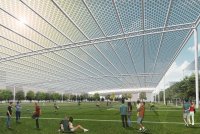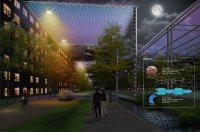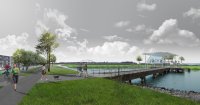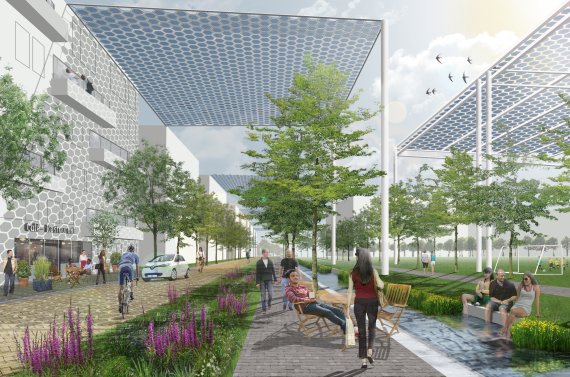Illustrations: Tom van Heeswijk
We all like the idea of a sustainable city. Why not, if it is good for the environment? But what would such a city look like? How does a sustainable energy supply fit into an urban environment? Huge wind turbines everywhere you look? Not very likely. Many people are opposed to wind turbines because of their visual impact. A year ago, Master’s student of Landscape Architecture Tom van Heeswijk saw a nice subject here for his thesis research: can you generate sustainable energy in a city in a way that is accepted by the public?

He applied his question to solar energy. A practical choice. Wind turbines are not only much the most controversial source of sustainable energy, they are also hard to integrate into an urban environment. Van Heeswijk: ‘Wind turbines take up a lot of space. Solar energy offers many more design options. You can get solar panels in all sorts of shapes and sizes. You can play around with them.’
Playing with solar panels
That creative playing with solar panels leads to faster acceptance, as Van Heeswijk showed in a study he did before he started to design anything himself. He studied how residents from Ouddorp, Almere, Nijmegen and Oss felt about an existing solar panel project in their area.

Solar cells with an extra layer of OLED lamps make it possible to have night-time lighting in any colour you want. According to Van Heeswijk, residents could vote online every day on what colour the lighting should be.
The message was clear: the more attractive the design into which the solar panels are integrated, the greater the acceptance. And if it serves another purpose besides that of generating energy, all the better. Van Heeswijk took this message to heart and came up with the simple idea of the pergola. Nothing could be more Dutch than a pergola with plants providing shelter from strong sunshine. But Van Heeswijk covers his pergola not with plants but with solar panels. Not the standard ones found in large numbers on roofs but a semi-transparent and flexible foil known as organic solar cells.
For the practical application, Van Heeswijk used a section of the Amsterdam housing project Zeeburgereiland as a laboratory. The pergola idea turned into canopies for a range of public spaces such as streets, café terraces or sports fields. The solar canopies in question are not solid but are made up of separate modules connected with cables, with enough space between them for rain or snow to drain away. The designs look futuristic, and they are. There are sure to be plenty of ifs and buts that could get in the way of actual implementation of the idea. ‘It doesn’t necessarily have to be totally achievable,’ explains Van Heeswijk. ‘The point is to inspire people and get discussion going. But I do believe this will become feasible in future.’

Van Heeswijk was given a 9 for his thesis by his supervisors Sven Stremke and Rudi van Etteger. But that wasn’t the end of the story. Stremke encouraged him to send his idea in to the Post Fossil City competition run by the Urban Futures Studio at Utrecht University. There too, his designs were received with acclaim. Of the more than 250 entries from 40 countries, that of Van Heeswijk and his team got through to the final round. He will have to compete with nine other finalists. The designs will be exhibited in Utrecht on 15 June. On the same day the winner will be announced and presented with a cheque for 10,000 euros.
Living lab
Van Heeswijk’s designs stand a chance of becoming more than an applauded exercise on paper. There are cautious plans to get a pilot off the ground in Binckhorst, a neighbourhood of The Hague. The Wageningen team, which besides Van Heeswijk is made up of landscape architects Sven Stremke and Wiebke Klemm and artist Sabrina Lindemann, are keen to test the solar canopies in a ‘living lab’. Klemm: ‘With municipalities, market players and users we can then see what the results are in terms of energy production as well as the effects on things like the climate and air quality in the city, and how residents feel about the canopies aesthetically. We are now looking for other possible partners and locations besides the one in The Hague. ’

